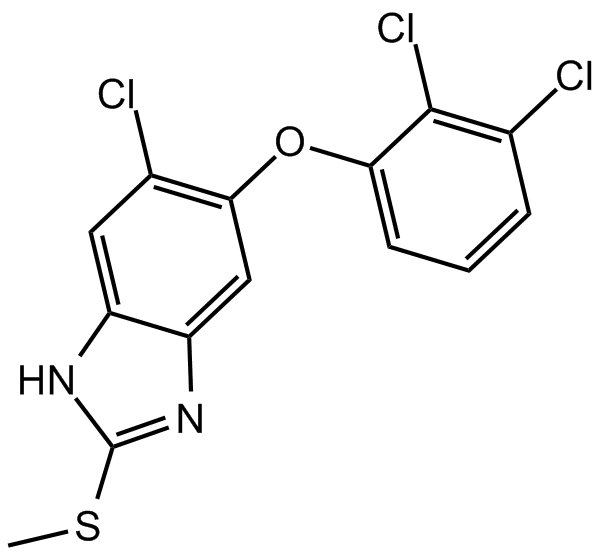Triclabendazole (Synonyms: TCBZ) |
| Catalog No.GC10537 |
Microtubule associated inhibitor
Products are for research use only. Not for human use. We do not sell to patients.

Cas No.: 68786-66-3
Sample solution is provided at 25 µL, 10mM.
Triclabendazole(CGA89317) is a benzimidazole, it binds to tubulin impairing intracellular transport mechanisms and interferes with protein synthesis.Target: Microtubule/TubulinTriclabendazole treatment produces percentage decreases of the fluke egg output by 15.3%, 4.3% and 36.6%, respectively, in sheep, dairy cows and heifers, these results indicate the presence of TCBZ-resistant Fasciola hepatica in sheep and cattle on this farm [1]. Triclabendazole sulphoxide (50 mg/mL) results in extensive damage to the tegument of triclabendazole-susceptible F. hepatica, whereas triclabendazole-resistant flukes shows only localized and relatively minor disruption of the tegument covering the spines [2].Triclabendazole is metabolized into a number of compounds, depending on the route of administration, plasma levels peak at 18-24 hours (Triclabendazole sulphoxide) and 36-48 hours (Triclabendazole sulphone), neither Triclabendazole nor any toher metabolites can be detected in plasma. Triclabendazole sulphoxide blocks the transport of secretory bodies from the cell body to the tegumental surface, the block occurs at the site of their formation by the Golgi complex in the cell body, in their movement through the cytoplasmic connections to the syncytium, and in their movement from the base to the apex of the syncytium. Triclabendazole binds to the colchicine binding site on the β-tubulin molecule and this has been used at the basis for evaluating the relative acitvity of Triclabendazole [3].
References:
[1]. Moll, L., et al., Resistance of Fasciola hepatica against triclabendazole in cattle and sheep in The netherlands. Vet Parasitol, 2000. 91(1-2): p. 153-8.
[2]. Robinson, M.W., et al., Triclabendazole-resistant Fasciola hepatica: beta-tubulin and response to in vitro treatment with triclabendazole. Parasitology, 2002. 124(Pt 3): p. 325-38.
[3]. Fairweather, I., Triclabendazole: new skills to unravel an old(ish) enigma. J Helminthol, 2005. 79(3): p. 227-34.
Average Rating: 5 (Based on Reviews and 31 reference(s) in Google Scholar.)
GLPBIO products are for RESEARCH USE ONLY. Please make sure your review or question is research based.
Required fields are marked with *




















